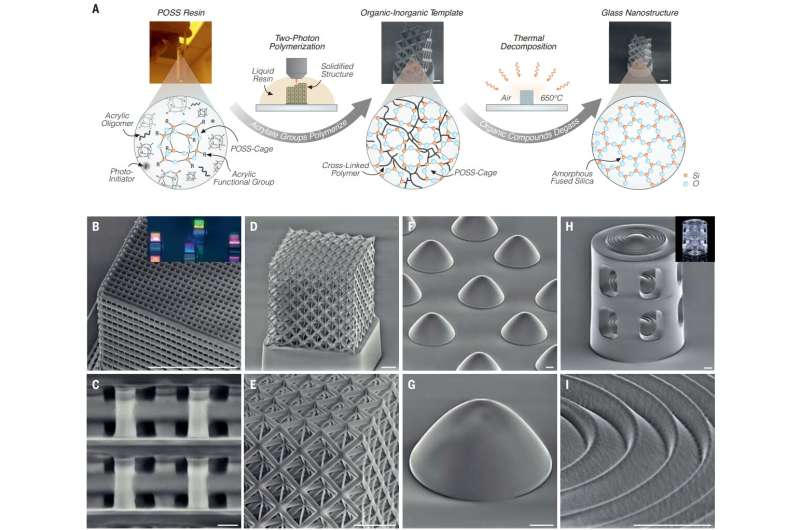June 5, 2023 report
This article has been reviewed according to Science X's editorial process and policies. Editors have highlighted the following attributes while ensuring the content's credibility:
fact-checked
peer-reviewed publication
trusted source
proofread
New way to conduct 3D printing of nanoscale silica glass allows for much lower temperatures

Material scientists from Karlsruhe Institute of Technology, the University of California, Irvine and Edwards Lifesciences have developed a way to 3D print nanoscale glass structures at much cooler temperatures than prior methods.
In their study, reported in the journal Science, Jens Bauer, Cameron Crook and Tommaso Baldacchini used their technique to print a variety of nanostructures. Paolo Colombo and Giorgia Franchin with the University of Padova, have published a Perspective piece in the same journal issue outlining methods used to print nanoscale glasses and ceramics and the work done by the team on this new effort.
In recent years, 3D printing has been applied to a variety of applications, resulting in impressive works of art, less expensive products and highly detailed physical models. One application that has generated interest is 3D printing objects at the nanoscale—such objects are of use in creating tiny electronic devices, particularly those parts that use light. Up until now, most such applications have been limited to producing objects made from polymers due to the ease with which the base material can be melted and then allowed to harden by cooling.
But polymers do not provide the resolution needed for light-based nano-photonics. Unfortunately, attempts to print 3D glass structures have been only partially successful due to the extremely high temperatures required for sintering (melting to form a solid mass). In this new effort, the research team found a way to print nanoscale structures at temperatures nearly half those of traditional approaches.
Instead of using suspended silica nanoparticles, as with other methods, the researchers created a liquid resin cage-shaped structure around polyhedral oligomeric silsesquioxane molecules. The team then used the resin as an ink to 3D print objects and then heated them to 650°C (other methods requiring heating to 1100°C). Heating got rid of the organic components and forged the cages into a continuous glass material.
The team tested their approach by 3D printing microlenses and other tiny objects and suggest it could be used for on-chip printing of optical-grade fused silica.
More information: J. Bauer et al, A sinterless, low-temperature route to 3D print nanoscale optical-grade glass, Science (2023). DOI: 10.1126/science.abq3037
Paolo Colombo et al, Improving glass nanostructure fabrication, Science (2023). DOI: 10.1126/science.adi2747
Journal information: Science
© 2023 Science X Network





















